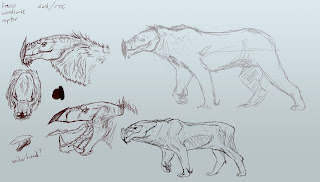Between my essay and my MA poster I didn't have enough time to focus solely on finished pieces, thus I have gathered a lot of spare sketches and ideas that don't always apply to other creatures in this mini-project. I also have some other creatures to finalise and then add in separate blog posts shortly.
Sketches
Digital sketches based on R.J. Palmer's first skillshare video. Technique is to build shapes first, like a ribcage, and then design a creature based on that, using knowledge of various creatures (his tend to be dinosaurs). Some of mine bled into later creature designs.
Idle sketch of woodlouse armour and fu dogs. From very early on in the project.
Brush pen. Following the idea of a creature that hides as a boulder, with rabbit-like fern ears and other plant-like protrusions that are actually external gills so it could survive underwater. Bottom sketches are of amphipods, something I'd just seen an article on and decided to copy.
Watercolour of said rock/rabbit in its environment. Used a reference. Despite the simplicity, I really like the effect, so I might try basic background details on my next creatures.
Double page spread of ideas for a bull creature with mantis arms that act as a shield, based on the design of an amphipod's armour.
Digital follow-up to the above. The headshots evolved into a more dragon-like creature, however. Both ideas (the head and the body) might come into play in other, later creatures, but at the moment I'm out of ideas for how to progress with either.
Further sketches based on the previous two ideas, breaking off into different creatures.
Break from the previous bull/mantis. Looking for shapes.
Quick sketches from screenshots from my favourite animal documentary, "Return of the Giant Killers: Africa's Lion Kings". I really like the idea of predators taking down huge prey unused to being attacked, and hope to include it in a later idea. Animals included are lions, elephants, pelicans, and buffalo.
Looking at head shapes.
Continuing from the top of the previous image. Digital sketches testing a body style for the creature. It doesn't work out so I left it for now.
Silhouettes of collected animal imagery, looking for shapes and inspiration. The pencil sketches explore ideas of tusks and teeth in different ways.
More silhouettes of creatures, only some from imagery. Chimps/gorilla were inspired by rewatching "Rise of the Planet of the Apes", as I realised I'd never drawn them. The silhouettes to the right of the four apes are using ape head shapes, but upside down.
Coloured brush pens, as a break from black. Found out some have a dry brush effect when used quickly, so I explored different shapes and textures, and what I could read from the end result. I really like some of them as headshots for monsters.
First attempt at Mudbox in almost two years. Tried to recreate Ribas, my sabre-toothed cat creature. Only got one tooth half-done, as I couldn't figure out how to aptly recreate it and get them to a fine point. Also, it was on a high level of detail but the front muzzle, where the teeth should go, was very under-poly. I think I messed up early on and it carried over to the higher detail. Despite ultimately being a failed piece, I did learn a lot (definitely need an orthographic of what I'm trying to sculpt, for instance) and I will probably spend another few days trying again.
Reflection
- Coming back to traditional art between digital pieces was liberating, and often gave new insight into a design.
- Exploring headshots is a good technique to make a creature more unique, as gazes focus on the face most, and the body can be built to match.
- Creature silhouettes were useful to break down shapes.
- Watercolour was difficult to produce due to limited colour range, but once I realised I didn't have to copy the reference exactly, it became its own piece and I really like how it turned out.
- I'd like to try clay modelling. The failed Mudbox attempt became annoying due to my lack of experience with the program, and the mistakes I made early on really impacted my ability to finish the piece properly to a degree I was happy with. Clay would be more forgiving, and would give a physical maquette I could use in illustrations, for lighting and pose purposes, like James Gurney uses.








